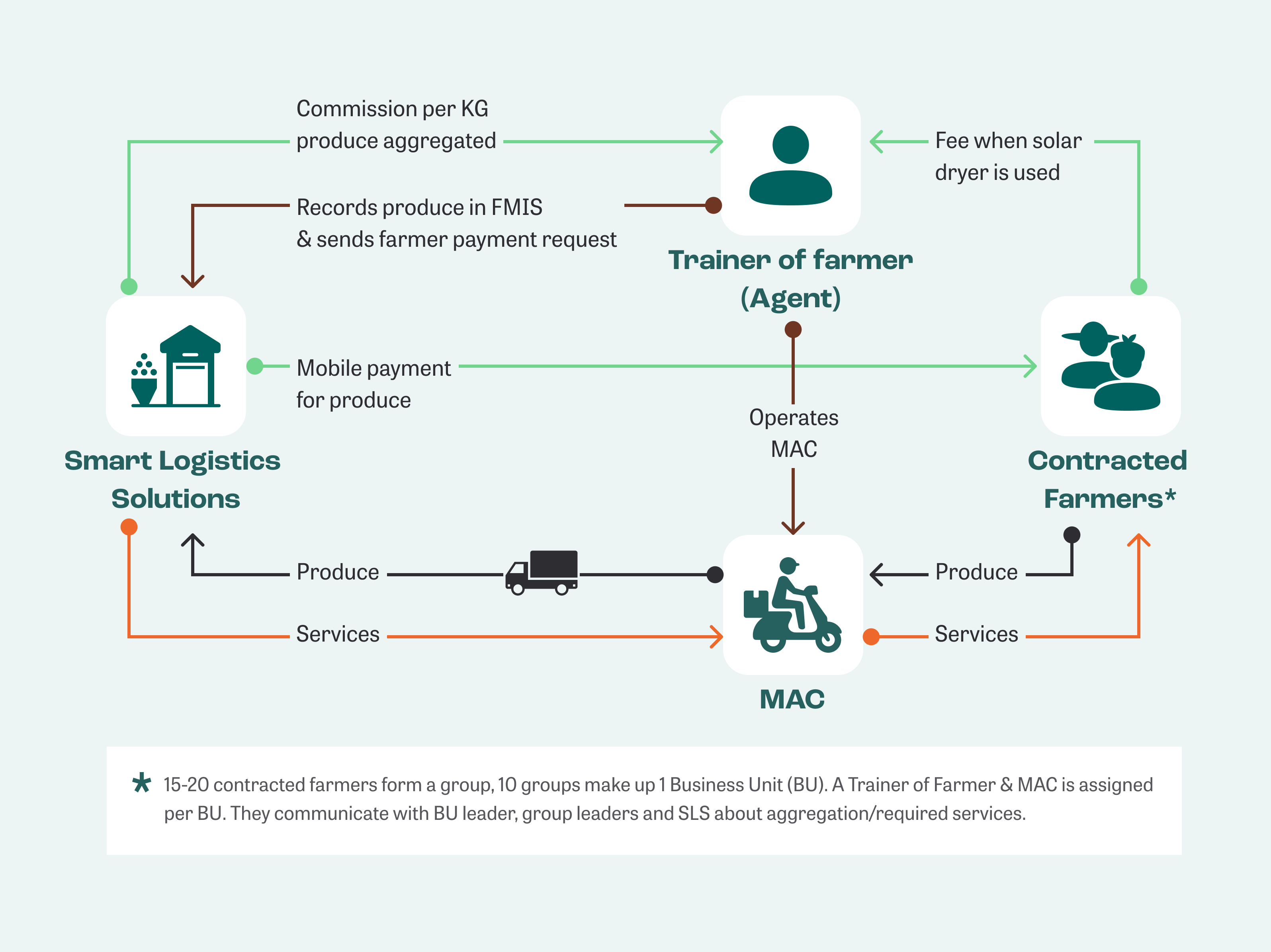Mobile Aggregation Center (MAC): an aggregation and service solution in smallholder agriculture
What is the Innovation?
Mobile Aggregation Centers (MACs) are a motorcycle-based service and aggregation solution operated by agents (incl. women and youth). They feature a digital weighting scale, a receipt printer, a moisture meter, a mobile solar drier (optional) and a GrainPro storage bag to aggregate produce prior to collection. These aggregation and service centers, embedded in the company’s service and sourcing model, are installable in different locations.
Key Challenges Addressed
A thorough assessment of SLS’ service delivery model revealed high operating and financing costs and a strong reliance on stable commercial revenues. High aggregation costs was a key challenge. Traditionally, SLS relied on physical warehouses to aggregate produce, but these required long-term capital-intensive investments. To allow for growth, SLS tested more flexible solutions, such as renting village shops or buying on trucks, but efficiency gains were limited. In addition to lowering sourcing costs, SLS’s commercial viability also relies on a sustainable supply base built around loyal and resilient smallholder farmers (SHFs). Yet, SHFs in the region lacked access to markets and post-harvest services to improve their livelihoods. MACs emerged as a flexible, transparent, and cost-efficient solution for SLS to source from SHFs, while efficiently offering a nearby market and post-harvest services to SHFs.
How it Works

Tips for Replication
Context
- GrainPro bags used in MACs can be used for dry commodities
- No restriction on geography
Best Practices
- Leverage group structures for efficient last mile delivery
- Use Farmer Management Information System & direct mobile payment for efficient and transparent procurement
- Integrate agents in servicing/sourcing model (e.g as Trainer of Farmers), incentivise via fees
- Use agents from farmers' communities to build farmers' trust
Enabling Conditions
- Internet access for immediate payment and use of FMIS
- Farmers' access to bank/mobile money account for payment
- Agents' access to motorbikes and (affordable) gas
- Company access to truck(s) to collect products from MACs
- Loyal agents and a well-organised contracted farmer base
Business Case
Expected Outcomes for Smart Logistics Limited
Sourcing Volume +60%
Since MACs were established in 2020, the company’s sourcing volume has increased by 60%. In addition, a drop of 80% in rejection rate was reported since the use of MACs.
Cost to Source +50%
The company reported a reduction in sourcing cost by 50% since the use of MACs. This is due to cost savings because renting and maintaining storage facilities and hiring security is obsolete, and there are lower costs involved in the loading and offloading of produce and aggregation management and logistics.
Side selling reduced
The transparency enabled by the digital scale has strengthened the relationship between SLS and farmers leading to improved loyalty. MACs bring collection points closer to the farmer (<2km), issue a receipt, and allow for more timely payment and for the storage of farmers’ produce further reducing the risk of farmers turning to alternative markets.
Impact Case
Expected Outcomes for smallholder farmers
Enhanced Market Access
By 2022 >3000 farmers accessed MACs. Many expressed their preference for selling to SLS over brokers as the MAC is trusted, allows for timely selling, and creates financial records via mobile payment and FMS records. Also, for farmers, especially women, reduced market distance (and dryer services) free up time for other (often revenue generating) activities.
Post-Harvest Losses to 10%
Farmers claim reduced post-harvest losses due to the storage solution and dryer technologies. This is confirmed by SLS who reports that post-harvest losses that typically amounted to 30% have been brought down to 10% since the use of MACs.
Income Diversification
Many of the agents are lead farmers earning a commission based on the volume of beans aggregated via the MAC and whenever additional services, such as drying technologies are used by farmers. Several agents, including youth and women, expressed that they welcome this opportunity to reduce their reliance on income from farming only.
Learn more about the MAC in this video
Data Sources & Disclaimer
Information is based on IDH’s Service Delivery Model (SDM) analysis for SLS, including data from SLS and 316 farmers (information is available on our methodology for SDM Analyses and Farmer Surveys). Additionally, company interviews and focus groups with farmers have been held since the start of Technical Assistance (2020) during which the innovation is tested and scaled. A longer time span and additional data are needed to verify and quantify impacts. Farmfit will conduct an end-line assessment of the company’s SDM and farmer livelihoods based on a repeat data collection at company and farm level.